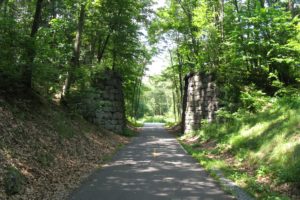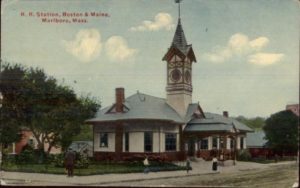
The Assabet River Rail Trail south of Washington Street in Hudson. The stone abutments were the base of what was known as the “Farmer’s Bridge” over the railroad line. It was removed during construction of the trail.
By Brett Peruzzi, Contributing Writer
Region – Most local residents just think of the Assabet River Rail Trail as a tranquil, paved pathway for a walk, run, or a bike ride. But in the middle of the nineteenth century, its construction as the Marlborough Branch of the Fitchburg Railroad was a turning point in the industrialization of the communities it serviced.
Trains serviced local industry and carried passengers
Prior to being incorporated as a separate town in 1866, Hudson was called Feltonville. It was a neighborhood and unincorporated village of Marlborough, where several dozen shoe factories would eventually thrive. Not only did the rail line provide a critical transportation method for the shoe industry and other manufacturers to bring their products to market, but it also carried passengers. They could travel to not just other communities on the branch line, but to more distant destinations such as Boston via connecting rail lines.
The Fitchburg Railroad began in 1842 to run between Fitchburg and Boston to service the docks in Charlestown, but several branch lines and extensions would be added over the years. Transcendentalist writer Henry David Thoreau of Concord was apparently not a train enthusiast, particularly because the Fitchburg Railroad ran close by his cabin at Walden Pond. He famously complained that he could walk to Fitchburg faster for free, considering the amount of time he would have to work to earn the cost of the fare, and enjoy the journey more. Eventually, the Fitchburg Railroad would expand into New Hampshire and Vermont, all the way to Canada, with over 450 miles of track that it controlled.

This imposing railroad station was built in Marlborough by the Fitchburg Railroad in 1893. Despite local preservation efforts, it was torn down in 1987.
The Marlborough Branch was incorporated in 1852 and began service in 1855. It started from a rail junction in South Acton that had already extended southwest into what would later become Hudson. The branch was 13 miles long and included stops in South Acton, Maynard, Lake Boone, Gleasondale, Feltonville and Marlborough. The first passenger depot in Marlborough on Prospect Street was later replaced by another one at Lincoln and Mechanic Streets in 1893 to accommodate the increase in passenger traffic. But the growing popularity of automobiles in the 20th century had increasingly more impact on business, and passenger service ended in 1939. The rise of commercial trucking and the decline of the shoe industry caused a decrease in demand for freight trains in the decades that followed, and the last train rolled down the tracks of the Marlborough Branch in 1980.
Rail trail resurrects a long-neglected resource
After languishing for more than a decade, in 1992 two Hudson residents had an idea for repurposing the old railroad bed. They proposed creating a paved recreational trail that would connect Marlborough, Hudson, Stow, Maynard and Acton. As much of the rail bed runs along the Assabet River, the volunteer group that formed around the concept came up with the Assabet River Rail Trail (ARRT) name. The group made numerous presentations to government officials and civic organizations in the communities the trail would run through, but it wasn’t until six years later, in 1998, that all the municipalities had voted to begin the project. The groundbreaking for the Marlborough-Hudson section of the ARRT was held in September 2003, and it was completed exactly two years later.
For over fifteen years now, the quiet whirring of bicycle tires and the soft slap of running shoes on asphalt have greeted users of the ARRT. In a place where long ago immense steel wheels screeched down the rails below heavily loaded boxcars, and train whistles once blew.











